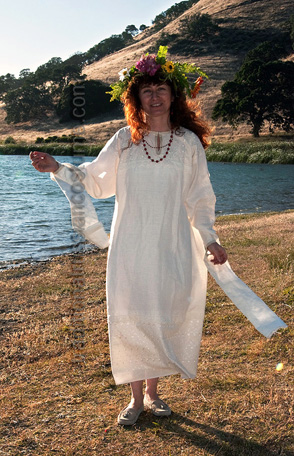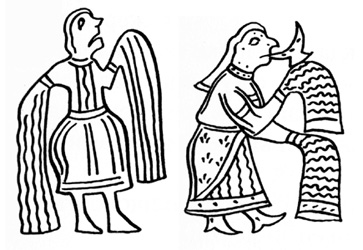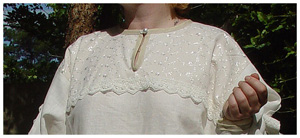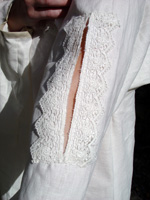
| Outfits >>> Replicas >>> Ritual dress for "rusalka" rite. | ||

|
| |
|
Extra-long-sleeved dresses were known in Russia between the 9th and the 19th centuries. They were used as an outfit for special occasions like celebrations and some rituals. False sleeves could be worn in a loose manner (like on the photo). Or, women fixed them with metal bracelets, makikg fancy folds.
Speaking of rituals, such a dress was mandatory for "rusalka" rites. Those rites were dedicated to spirits of trees and rain clouds. The word "rusalka" appeared in Slavic languages not earlier than 1600s. Before that time, Slavs named "rain maidens" as Veelahs or Mavkahs. Some Slavic peoples continue to use those ancient terms instead of modern "rusalka" even nowadays.
In case of a drought, rain maidens' ritual should be performed right at a grain field. As a part of a worship, a water had to be poured over a head of a priestess who wore a "rusalka" dress. Drops that oozed from wet long sleeves symbolized a rain needed. In accordance to archaic magic, that should produce a real rain. If a weather was normal, Veelahs' rite was a part of a regular "rusalka week" celebration. Dodola priestesses danced in a grove on a river bank then. They waved their hands with "wings" (false sleeves) to attract an attention of "sisters from clouds" to a grain field and sprouts.
The picture engraved on silver bracelets of the 12th century depicts dodolas in their ritual dresses. Waves on sleeves symbolize water and rain (a wave is a sign for water in all Slavic cultures).
A waistband was not allowed for a "rusalka" outfit too. So did a necklace. Those two were considered by Slavs as a proof of a human nature of a wearer (spirits have never worn belts).
A false sleeve ("a wing") of a dress should be sewn extremely long and narrow. On a wrist level there was a hole for a hand. A decorative cut between a shoulder and an elbow was an usual detail for Russian shirts and dresses of the 14th - 17th centuries. A cut could be embellished with lace or an embroidery.
| ||
Sources (in Russian)
| ||



